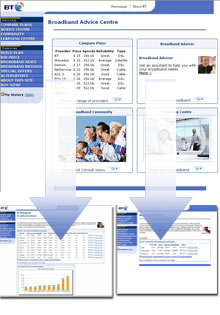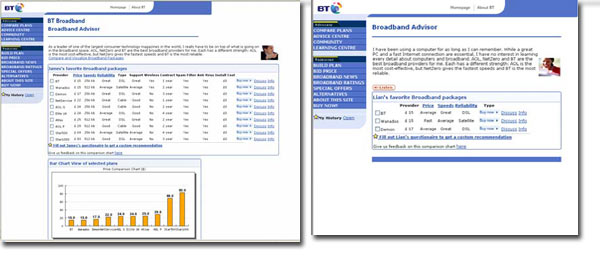Applied psychology for web design
Sites that can be modified depending on the way a visitor thinks can benefit from e-commerce.
It is far from easy to create such a site that any visitor would like. Someone prefers simple phrases on a clean page, while others prefer to deal with tables and graphs. Researchers at the Faculty of Management named after Sloan at MIT have developed a technology that allows you to automatically adapt the site to each specific visitor, so that the information on the site is presented in accordance with the type of thinking of each individual. The researchers hope that their technology will help to achieve greater efficiency in online trading.
According to initial research, it turned out that a site that gains the ability to change its shape, adjusting to different types of visitors, can increase its sales to 20 percent. Some sites, for example, Amazon.com, now offer the possibility of personalization, but they adapt to the visitor based on information from his personal profile, left cookies or obtained through long surveys. At the same time, Sloan's system adapts to an unfamiliar visitor during the first few clicks he makes on the website, analyzing his manner of working with information.
Sloan's marketing professor, John Houser, explains that the system will help sites determine the type of thinking. It will monitor exactly which elements are of primary importance to the user and rebuild the site based on this. Changes will be almost imperceptible. “Suddenly, you find that the site has a clearer, more user-friendly navigation, and it contains exactly the information you need,” says Hauser. In his opinion, the user should not even guess that the site is personalized.
')
Researchers have developed a prototype of such a site for British Telecom, which is intended for the sale of broadband Internet connection. The website is designed in such a way that the very first few clicks of a visitor will allow the system to determine its type of thinking. For example, the very first page that a user sees allows him, along with other possibilities, to compare tariff plans in the table or to communicate with a consultant. “It’s easy to see that visitors with a more analytical mindset would rather compare tariff plans than seek help from a consultant,” says Houser. For the first 10 clicks, the system determines the type of thinking and rebuilds the site in such a way that it most closely matches. “If we determine that you like working with graphs, then you will immediately be presented with information in the form of graphs,” he says. “If we determine that you attach importance to the advice of your peers, you will see a lot of advice from your peers.”
The head of the Laboratory for Personalized Adaptation Systems at the School of Computer Science at the University of Pittsburgh, Peter Bruclavsky, believes that although a lot of work was done to adapt the web pages for users according to their type of thinking, in most cases this was done for the sake of study, but not ecommerce. In his opinion, the idea of the guys from Sloan is of interest. Along with the fact that personalization is a value, regardless of whether it happens automatically or with the conscious participation of the user, Brusilavski believes that “what can be achieved with the help of automation is absolutely impossible to achieve with the help of the user, because, as a rule, users they don’t want to spend enough time on it, and they can’t always be aware of why it’s important (to adapt the page for personal characteristics). He believes that this technology has great prospects in the annex to mobile Internet pages, which, due to limited size and inconvenient interfaces, are difficult to personalize by the user.
Professor Bamshad Mobascher of the School of Computer Science at the University of dePaul in Chicago, who studied the topic of adapting websites based on the analysis of user manners to click, says that many works in this area, including his own, are based on simply comparing the user with other users, who clicked on the site in a similar way, absolutely not trying to understand what a particular click style means by itself. In his opinion, the introduction of a psychological component takes web design to a new level, and he would also be very interested in finding out how much this approach would be more productive than stupid tracking of user behavior in the past.
Marketing professor from Sloan, Gleb Urban, who participated in the study, said that the team plans to develop a full version of this system for the Japanese company Suruga Bank . For the Suruga project, which the MIT Digital Business Center is currently working on , researchers plan to analyze web site visitors for their cultural and mental characteristics, determining which society’s view is more intrinsic to visitors - hierarchical or horizontal, that is, is it great value personal benefit or the benefit of the whole society. Someone who has a hierarchical view of society may, for example, get advice on lending from some authority, at the same time, someone with a horizontal attitude will receive advice from a person like himself. Likewise, a personal inclination towards individualism, or towards collectivism, may influence which properties of a product should be highlighted. Urban believes that if the experiment goes well, then it is easy to foresee, as in the future, companies will use the techniques of adapting websites, which will rearrange themselves for specific users, depending on their cultural and psychological characteristics. Also, researchers are working on using these technologies to improve the effectiveness of banner advertising.
Translation from English:
Roman Ravve
Crossposted from worldwebstudio
 |
| Reincarnation: British Telecom website, analyzes the user's behavior and changes its shape, depending on its psychological characteristics. For example, determining whether a visitor has an analytical or emotional mindset, the website is rebuilt so that it is more convenient to sell the desired product to this user. |
According to initial research, it turned out that a site that gains the ability to change its shape, adjusting to different types of visitors, can increase its sales to 20 percent. Some sites, for example, Amazon.com, now offer the possibility of personalization, but they adapt to the visitor based on information from his personal profile, left cookies or obtained through long surveys. At the same time, Sloan's system adapts to an unfamiliar visitor during the first few clicks he makes on the website, analyzing his manner of working with information.
Sloan's marketing professor, John Houser, explains that the system will help sites determine the type of thinking. It will monitor exactly which elements are of primary importance to the user and rebuild the site based on this. Changes will be almost imperceptible. “Suddenly, you find that the site has a clearer, more user-friendly navigation, and it contains exactly the information you need,” says Hauser. In his opinion, the user should not even guess that the site is personalized.
')
Researchers have developed a prototype of such a site for British Telecom, which is intended for the sale of broadband Internet connection. The website is designed in such a way that the very first few clicks of a visitor will allow the system to determine its type of thinking. For example, the very first page that a user sees allows him, along with other possibilities, to compare tariff plans in the table or to communicate with a consultant. “It’s easy to see that visitors with a more analytical mindset would rather compare tariff plans than seek help from a consultant,” says Houser. For the first 10 clicks, the system determines the type of thinking and rebuilds the site in such a way that it most closely matches. “If we determine that you like working with graphs, then you will immediately be presented with information in the form of graphs,” he says. “If we determine that you attach importance to the advice of your peers, you will see a lot of advice from your peers.”
The head of the Laboratory for Personalized Adaptation Systems at the School of Computer Science at the University of Pittsburgh, Peter Bruclavsky, believes that although a lot of work was done to adapt the web pages for users according to their type of thinking, in most cases this was done for the sake of study, but not ecommerce. In his opinion, the idea of the guys from Sloan is of interest. Along with the fact that personalization is a value, regardless of whether it happens automatically or with the conscious participation of the user, Brusilavski believes that “what can be achieved with the help of automation is absolutely impossible to achieve with the help of the user, because, as a rule, users they don’t want to spend enough time on it, and they can’t always be aware of why it’s important (to adapt the page for personal characteristics). He believes that this technology has great prospects in the annex to mobile Internet pages, which, due to limited size and inconvenient interfaces, are difficult to personalize by the user.
 |
| Two kinds of the same site: the prototype site, which researchers at MIT have developed for British Telecom, takes different forms, depending on the type of visitor’s thinking. On the left is an example of what a visitor with a more analytical, visual type of perception can see: a web page filled with graphs and tables. On the right you can see an example of what a more holistic, emotional visitor will see. This option displays the minimum amount of information, leaving three basic options for tariff plans. |
Professor Bamshad Mobascher of the School of Computer Science at the University of dePaul in Chicago, who studied the topic of adapting websites based on the analysis of user manners to click, says that many works in this area, including his own, are based on simply comparing the user with other users, who clicked on the site in a similar way, absolutely not trying to understand what a particular click style means by itself. In his opinion, the introduction of a psychological component takes web design to a new level, and he would also be very interested in finding out how much this approach would be more productive than stupid tracking of user behavior in the past.
Marketing professor from Sloan, Gleb Urban, who participated in the study, said that the team plans to develop a full version of this system for the Japanese company Suruga Bank . For the Suruga project, which the MIT Digital Business Center is currently working on , researchers plan to analyze web site visitors for their cultural and mental characteristics, determining which society’s view is more intrinsic to visitors - hierarchical or horizontal, that is, is it great value personal benefit or the benefit of the whole society. Someone who has a hierarchical view of society may, for example, get advice on lending from some authority, at the same time, someone with a horizontal attitude will receive advice from a person like himself. Likewise, a personal inclination towards individualism, or towards collectivism, may influence which properties of a product should be highlighted. Urban believes that if the experiment goes well, then it is easy to foresee, as in the future, companies will use the techniques of adapting websites, which will rearrange themselves for specific users, depending on their cultural and psychological characteristics. Also, researchers are working on using these technologies to improve the effectiveness of banner advertising.
Translation from English:
Roman Ravve
Crossposted from worldwebstudio
Source: https://habr.com/ru/post/31604/
All Articles